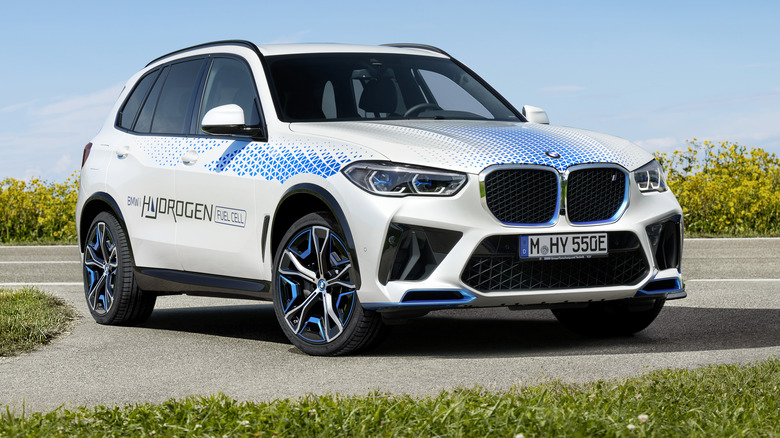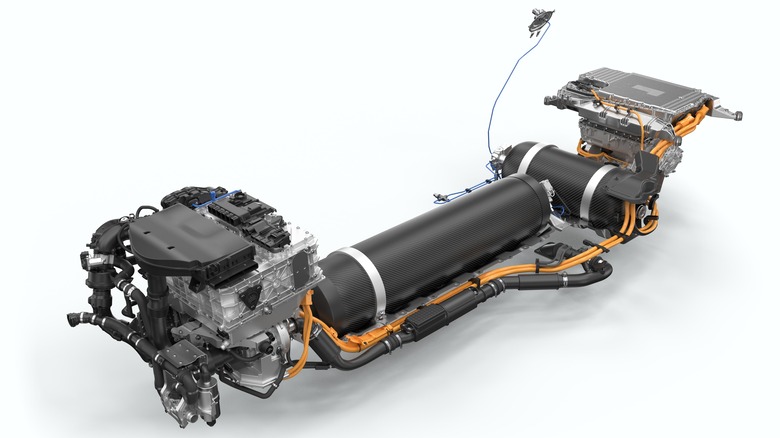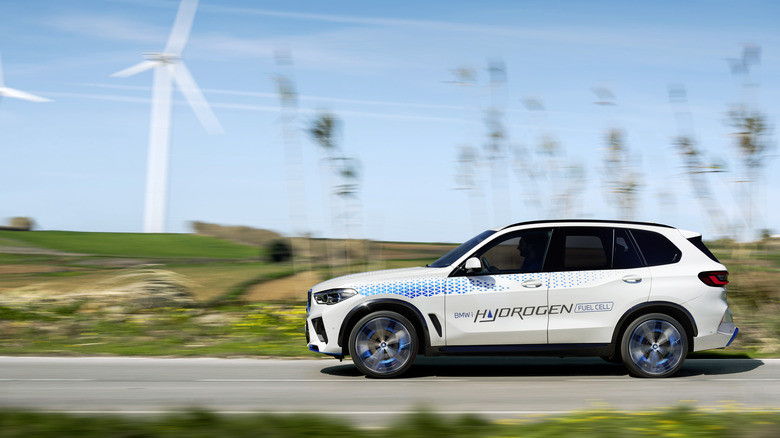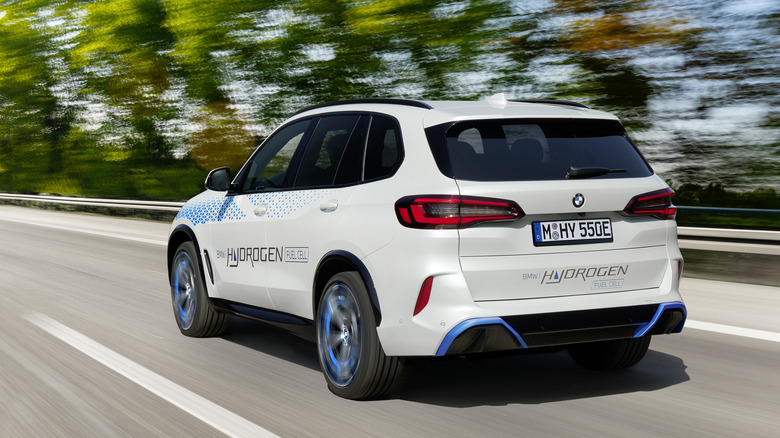BMW iX5 Hydrogen Production Starts, But Don't Expect To See This Fuel-Cell SUV In Dealerships
BMW has begun production of its latest electric car, though the iX5 Hydrogen is not the EV you might expect. As the name suggests, the electric SUV is based around hydrogen fuel-cell technology, taking the gas and using it to produce electricity with which the motor from its BEV cousin is powered. Until now a test bed, small-series production of the iX5 Hydrogen is now underway.
From the outside — at least, without the bold branding on the wrap — you'd be forgiven for not realizing the iX5 Hydrogen was any different from BMW's regular X5 SUV. That familiarity is, in fact, part of the FCEV's charm. Part of the advantage of the new drivetrain, BMW points out, is that it will fit into a regular X5.
Still, under the surface things are very different from the gas-powered X5. Lift the hood and you'll find the fuel-cell system, which takes hydrogen gas, combines it with oxygen, and turns it into electricity with only pure water as the waste product. Two hydrogen gas cylinders — one running longitudinally down the center of the SUV, the other at right-angles under the rear seats — hold around 6 kilograms (around 13 pounds) of the fuel.
Familiar shape hides a lot of new tech
Electrical power from the fuel-cell is then transferred to an electric motor at the rear, driving the rear wheels. It's topped by a li-ion battery: at only 2.5 kWh, it's a fraction of the battery inside the iX SUV, but it's only intended to supply boost power, hold energy created through regenerative braking, and store excess power generated from the fuel-cell system.
Altogether, the fuel-cell produces 125 kW (170 horsepower). The electric motor produces 275 kW, thanks to the contribution of the 150 kW power battery. It's enough, BMW says, for a 0-60 mph time of around 7 seconds.
Maybe more important, the configuration is also sufficient for a range of around 310 miles, BMW suggests. That's akin to a decent BEV SUV, but with far faster refueling times. In fact, you could be looking at a refuel in 5 minutes, a fraction of even a powerful DC fast charger for a fully-electric car.
Where's the fuel?
The downside, of course, is actually finding that hydrogen pump. Access to the gaseous fuel has long been one of the most significant bottlenecks for adoption of FCEVs. In Germany there are 100 stations, for example, but there are just 89 in America. That's limited both appeal and market availability of fuel-cell based cars.
At the same time, there are ongoing questions about just how green that hydrogen actually is. In Germany, for example, only around 30% of the hydrogen fuel is from renewable sources. The vast majority, worldwide, relies on grid electricity to produce.
Efforts are underway to address both of those issues. BMW highlights things like the Biden administration's investment into alternative power in the U.S., along with other hydrogen initiatives in more than 40 countries. The Alternative Fuel Infrastructure Regulation currently being negotiated in Europe could bring mandated hydrogen infrastructure; BMW is expecting that to be finalized as soon as the end of January 2023.
Passenger cars aren't hydrogen's big market
The reality, though, is that even with a small number of BMW iX5 Hydrogen SUVs being produced — using individual fuel-cells supplied by Toyota, but assembled into a stack by BMW using the automaker's own processes and technologies — the expectation is that hydrogen as a fuel will be predominantly of interest to non-passenger vehicles. Instead, it arguably makes the most sense, BMW suggests, for larger vehicles like medium- to heavy-duty trucks, along with the marine and aviation sectors. We've already seen Toyota reveal its plans for such an FCEV truck.
Despite that, and an acknowledgment that battery-electric vehicles will undoubtedly lead in the mainstream, BMW still believes there's a place for FCEVs. After all, the automaker argues, if the infrastructure is being built to cater for trucks, there's no reason not to also use it for passenger vehicles like the iX5 Hydrogen.
The results of the small-series production beginning today will be used as technology demonstrators across select regions from spring 2023, BMW says. It's unclear at this point how many will be built. Depending on the reception and the strengths of the technology, series production of a first model could follow mid-decade, ahead of a potential full portfolio of BMW FCEVs from the 2030s onwards.



